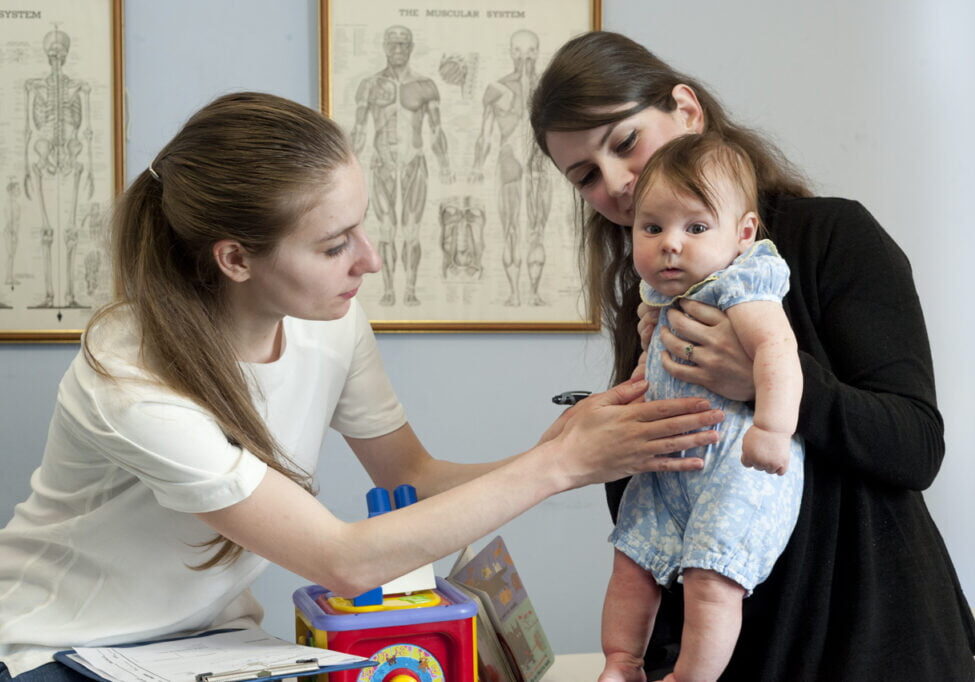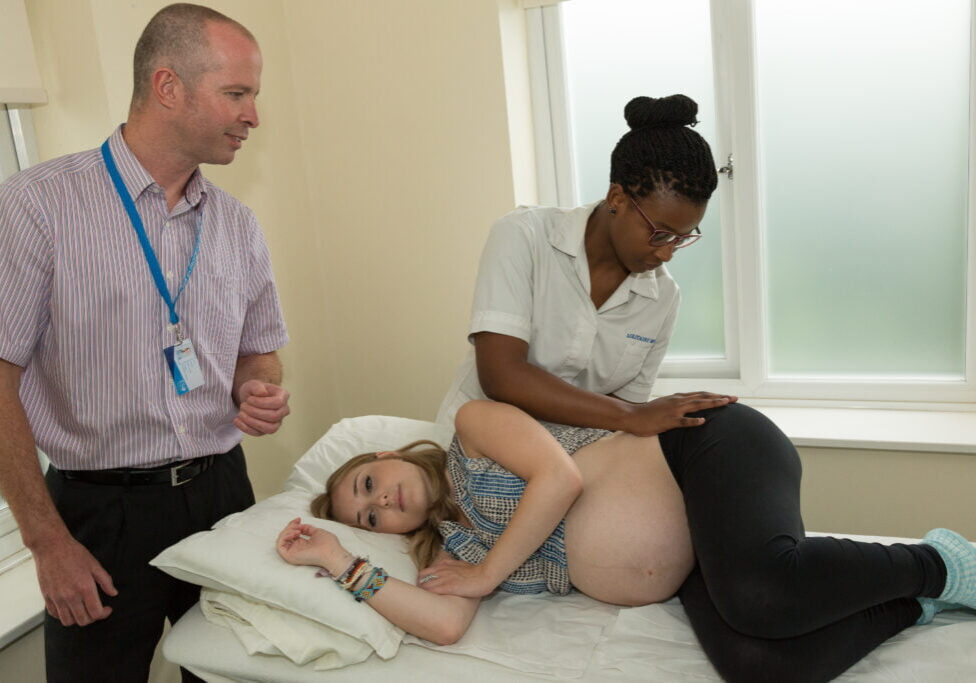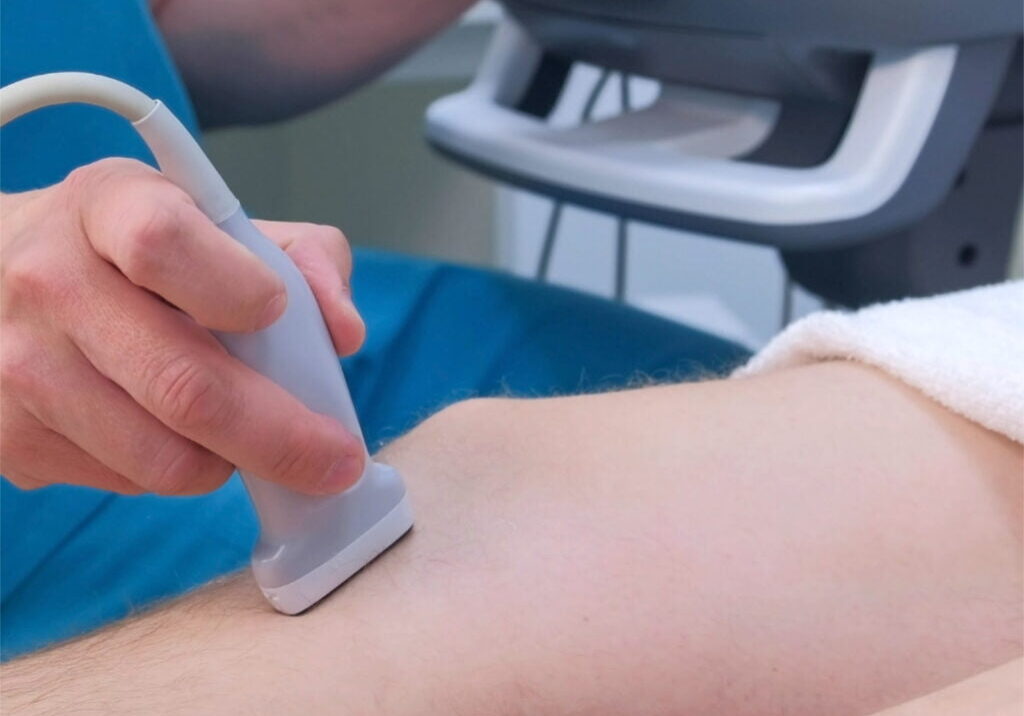Headache Clinic
Our specialist Headache Clinic was founded to help people living with debilitating persistent headaches.
If you have had a headache such as migraine, tension-type headache or cervicogenic headache (coming from the neck) for over 6 months, osteopathic treatment might help reduce your headache burden. It might also help if you have headaches related to jaw problems. This is because neck, shoulder, jaw and head pain are inter-related. Reducing tension in any of these ares can help with headaches, though not always.
If you have not had your headache for 6 months, please see a GP first to rule out anything else.
| Appointment Fees |
|---|
New Patient and Returning Patient Standard Consultation Fee - Daytime £30, Evening £30, no concession appointments available |
About Our Headache Clinic
Consultations are provided by final year student practitioners, closely supervised by an experienced headache-trained osteopathic tutor. The team carry out recognised safety screening procedures and a thorough assessment, followed by tailor-made advice and, where appropriate, treatment; often this means working hand-in-hand with the patient’s own or specialist health professionals. Above all, we encourage patients themselves to collaborate with us in our aim to help reduce the impact of their headaches on their lives.


You can find more information about headaches in the Q&A section below.
If you have any questions about the suitability of our Headache Clinic to your headache situation, please email clinic.eso@bcnogroup.ac.uk.
Our Headache Clinic lead, Helena Bridge, can call you to discuss your concerns.
Patients attending our General Clinic for help with headaches may also be referred to the Headache Clinic for re-evaluation if current osteopathic treatment is not proving effective.
Headache Clinic Times
Wednesday afternoons
First consultation: 1hr 20mins
Continuing consultations: 40mins
Do you suffer from headaches? 90% of the world’s population will have a headache at some point in their lives. Most of these are completely benign, last only 2 – 3 hours if not medicated, and do not stop us from functioning – they are generally dehydration, low blood sugar, or tension-type headaches. They should resolve with simple measures e.g. a glass of water, food, a break from the screen, or an over-the-counter painkiller respectively.
If they do not resolve this promptly, they may herald a virus or a sinus issue, or very rarely they may be secondary headaches due to a primary cause which needs medical attention. Most often, they will be primary headaches such as migraines, in which case we may be able to help you manage or help to prevent them. Beware of people who claim to cure migraines, as managing them is a matter of learning to balance your stresses and triggers as much as anything else e.g. treatment or medication. It is not a question of cure.
Many other headache types exist, and each headache sufferer needs careful screening and diagnosis before a treatment plan can be formulated.
These other headache types include migraine with or without aura, medication overuse headaches, cervicogenic headaches (arising from trauma or mechanical issues in the neck), frequent tension-type headaches, chronic headache, and rarer headache types e.g. cluster headaches, hemicranias and other trigeminal autonomic cephalalgias. These are excruciating and accompanied by unpleasant symptoms arising around the eyes, nose and face such as drooping eyelid, tear formation, red eyes, facial flushing, one pupil constricted and stuffed up nose for no apparent reason.
It is a complex process diagnosing headaches properly, and research shows that many people never get a correct diagnosis. At the ESO Clinic, you will firstly be safety screened.
Sinister headaches are rare but be aware: What follows is not a substitute for medical advice – seek urgent medical advice in the following situations:
People with severe, sudden onset headaches which may signal bleeds in the brain or other major health issues are rare but urgent, fast-unfolding scenarios and should never come to the ESO Clinic as a first port of call.
If this is a first, worst, or a sudden onset “thunderclap” headache, or accompanied by sudden change in bodily functions (e.g. balance, speech, paralysis) or by changes in consciousness (e.g. seizure, fainting, drowsiness), CALL AN AMBULANCE.
Persistent headache after head injury too requires medical screening (see www.nhs.uk/Conditions/concussion/Pages/introduction.aspx)
Seek prompt medical advice also in the following situations:
- If you have a headache and have a high fever or rash, or feel unwell
- If you are over 50 or around this age, and this is your first headache ever
- If your headache is different in nature from your regular ones and is accompanied by any unexplained symptoms e.g. visual disturbance, sudden loss of hearing, loss of balance, or other symptoms e.g. changes in consciousness, memory, confusion, co-ordination
- If you have had a familiar headache through your life and it changes dramatically in pattern (especially frequency over a few weeks), or it becomes progressively worse
However, if you regularly suffer from headaches which you would like help with, please contact the ESO Headache Cinic at clinic.eso@bcnogroup.ac.uk or on 01622 685989.
Headache is more common than back pain, and some headaches are very debilitating, even tension-type headaches. It makes sense for osteopaths to become involved in reducing any pre-existing tensions in muscles and joints as these can predispose you to these headaches. In order to help prevent these often life-wrecking symptoms, we can make sure your muscles and joints are functioning optimally. We are also well-placed to give basic advice on your work station and other occupational and postural issues leading to strain on the neck and shoulders.
Conversely, headaches can themselves be the cause a lot of neck and shoulder pains, especially in the case of migraines and other complex headache conditions. This may be because a lot of pain is directly referred from irritated nerves in the head and face, for example, or through the sheer stress of coping with the pain levels and other debilitating symptoms of the headache or migraine.
Osteopathy can help reduce mechanical and stress-related tension by addressing strain throughout your musculoskeletal system using gentle hands-on manipulative techniques of all kinds (see home page). We also give you time to discuss and consider all options open to you, based on the latest scientific evidence.
Yes and no: your osteopathy student is trained in assessing and helping to improve joint mobility and muscular tension throughout your body, and to educate you on making healthy choices.
By helping you to:
- move and breathe more comfortably
- relax mentally
- discuss your concerns & options together
- make informed choices on a management plan
- monitoring progress and adapting manual techniques to your particular sensitivity
We may be able to help with migraine prevention. The idea is to reduce the frequency and, if possible, the severity, though not to provide acute treatment or claim to cure migraine. It is a stepwise journey, often in collaboration with medical management in those with chronic migraine.
Not everybody will benefit from osteopathic treatment for migraine reduction. However, research has shown that even just having a speaking partner who will listen and share ideas with you can help reduce the stigma and isolation of migraine, thus reducing anxiety & lifting mood. It should be noted that clinical anxiety and depression tend to “lock in” migraine, so our approach has to be holistic and collaborative with other health professionals.
How does movement (or the lack of it) impact on migraine?
Migraine has a contradictory relationship with all its triggers: a cup of coffee can sometimes stop one coming on, other times bring one on. One of the things that can both aggravate or alleviate migraine is physical activity, which brings us to manual therapy for migraine.
It has been shown that many forms of exercise such as walking, running, swimming and yoga for example, can be beneficial to reducing migraine frequency. Reudcing frequency is also the main aim of any intervention such as osteopathic treatment. However, just before or once an attack has begun, almost any movement or physical treatment aggravates it.
How is migraine diagnosed?
Firstly, we listen carefully to your account of your headaches and ask questions during a detailed case history, which is the key to headache diagnosis. Signs of serious secondary headache need to be ruled out. This can be achieved through the case history unless certain “flags” for serious headaches are found. In such unusual cases we refer for medical screening – even then it is highly unlikely that the cause of your headache will be serious.
The headache characteristics such as duration, nature, location, severity, and associated features such as nausea, light and sound sensitivity, are all painstakingly catalogued in the Third International Classification of Headache Disorders. Our students learn to use this and current headache diagnostic guidelines to help diagnose common headache types such as migraine.
It is essential to determine what sort of headache you have as this indicates the options for the best-evidenced treatment approaches: migraine is very often self-diagnosed and poorly-medicated, or just misdiagnosed. For example, most people with migraine do not experience visual disturbances and yet many people associate the disquieting flashing lights and blurry vision of visual aura exclusively with migraine, so much so that studies suggest that at least 50% of migraineurs, including children, remain undiagnosed or misdiagnosed.
What is the osteopathic approach to migraine prevention?
Osteopaths may be able to help alleviate the burden of your migraine. This is done initially by safety screening for serious headache causes, referring on where needed. Assessing and diagnosing your migraine or other headache comes next.
Using evidence-based assessment approaches, your osteopath will perform some simple clinical tests such as taking your blood pressure, and checking your nerve function if needed, then fully assessing the functioning of your musculoskeletal system. This is relevant to your migraine because, as well as the life stresses already mentioned, the muscles and joints of your back, neck and shoulders, and the nerves of your upper (and also lower) neck can often play a contributory role in both generating and maintaining headache and migraine pain. Migraine is a major cause of neck pain during migraine attacks though, so it is important to assess the salience of any neck issues in your migraine.
Neck pain may be especially relevant where physical trauma has played a part in causing poor neck function, or where poor upper body function has resulted in a side-locked migraine. Recent research suggests that this strong one-sidedness of the headache aspect of the migraine might indicate a stubborn neck problem, and therefore perhaps a patient who could respond better to manual therapy than migraineurs whose attacks can start on either side.
Why do people seek hands-on help for migraine?
Most migraineurs feel that “there is something the matter” with their neck, and manual therapies are the alternative treatment of choice in the complementary medicine field. They can also struggle with their medications and be seeking other avenues for treatment. Many migraine sufferers are too sensitive to even the best medication available to them (the triptans), or the medications may have worked for a time and then stopped helping; we can return you to your `GP with a request for a medication review, but if pregnant, not wishing or too young to take medication, you may just want to give it a try. Osteopaths have many refined, gentle techniques in their therapeutic toolkit, and this makes us a safe and sensible choice for anyone wanting to explore whether physical therapy could help their migraines.
We need to remember that every migraine is unique to the sufferer, and it may not be possible to help everyone with osteopathy, or indeed medication. It is a case of finding a tailor-made approach which suits each individual, and this takes time and perseverance from doctors, osteopaths and other practitioners.
Introduction to migraine
Migraine is a complex and debilitating neurological disorder. Migraine is considered by headache experts worldwide to be a type of dysfunction of the nervous system. This results in a persistent inflammatory neurological condition which comes and goes. Sometimes it comes more than it goes, and this is called chronic migraine.
Migraine is a disorder affected by both our internal and external environments. Running strongly in families, it affects more women than men, and it does this more at certain times of life: it is most common in a woman’s most productive years!
How does migraine start?
The genetic predisposition to migraine makes our nervous systems highly sensitive and extra-vigilant. All it takes is a combination of stressors such as excessive sleep loss, blood sugar swings or the onset of hormonal cycles, for migraine to suddenly emerge. Once awoken, it seems to take on a life of its own, making migraineurs over-react to many aspects of “normal” modern life including bright lights, strong smells, irregular sleep cycles, poor eating & drinking habits or high stress levels. Even weather changes and altitude can bring on a migraine.
Every migraineur experiences migraine differently. Some lose vision, some lose muscular power, others experience speech lag or tongue muscle malfunction, all temporary and mostly resolving as the migraine headache begins, but most migraineurs have none of these. They just have the misery of pulsating, debilitating head pain, with nausea and/or extreme sensitivity to light and/or sound, and this for the rest of the day and often into the next couple of days as well.
This is about the number of DAYS a month on which you take pills for headache (or other pain), not about overdose, which is about exceeding a daily maximum dose.
If you are taking prescribed headache pills e.g. :
- triptans such as sumatriptan,
- or pills containing caffeine,
- or opioids such as codeine
- on more than 10 headache days per month
- for over 3 months
and your headaches have become daily during this time, the chances are that the medication itself is increasing the headache frequency. 10 days a month of headache pills equates to averagely exceeding only 2 days a week of headache pills.
This could equally true if you are taking over-the-counter tablets such as paracetamol or ibuprofen, but these only risk progressing to daily headaches if you are taking them on 15 days a month or more, for more than three months. (This equates to exceeding only three days a week of tablets on average).
In both examples, you may be suffering from medication overuse headache (MOH), and in the first example, this is called complex medication overuse headache; this term is also used for those who have tried and failed to break the cycle of MOH. For either form of complex MOH you will need support while you come off the pills and review your medication with your GP, headache nurse or headache specialist.
In the case of migraine medication, this medication programme to break the cycle falls into two camps: acute and prevention medication. If you suffer from 4-8 migraines/month, you may be put on prevention medication (such as amitriptyline), for a time. We can help you use the four-question Migraine-ACT tool to see whether you are due for a medication review.
The ESO Headache Clinic is especially suitable for those suffering from debilitating and persistent headaches, i.e. typically those who have more headache days than not. In the case of migraines, one a week is more than enough to warrant coming in to see if we can help.
Intermittent headache sufferers are also welcome if current treatment is not helping so far. The ESO Clinic has introduced this new service as part of the World Health Organisation’s worldwide call to help those living with headache sufferers, called “Lifting the Burden”.
Our Headache Clinic is headed by BCOM tutor Helena Bridge, who has specialist knowledge in the field after gaining a Master’s in Clinical Management of Headache Conditions through the School of Clinical Sciences at the University of Edinburgh in 2020. She is a founder member and a co-director of a new special interest group, Osteopaths for Progress in Headaches and Migraines who have recently completed a research project delivering an evidence based, road-tested course on headache assessment and management for all musculoskeletal allied health professionals.
Together, Helena Bridge and our student practitioners are able to:
- perform rigorous safety screening,
- diagnose the most common headache types,
- refer appropriately for medical support, and
- provide gentle, tailor-made osteopathic treatment to help reduce tensions known to contribute to headache symptoms
- treat cervicogenic headaches (neck-driven) which may aggravate your migraine condition
- signpost to other supporting treatments e.g.
- biobehavioural approaches for stress management,
- nutritional information for migraine prevention
- education on the importance of management of migraine co-morbidities (which could reduce the effectiveness of any migraine treatment you may be having, including osteopathy)
- give evidence-based exercise prescription for migraine and headache reduction
In the 5 March 2007 edition of Cephalalgia, LJ Stovner et al published an arresting article: The global burden of headache prevalence and disability worldwide. It states “Globally, the percentage of the adult population with an active headache disorder are 46% for headache in general, 11% for migraine, 42% for tension-type headache, and 3% for chronic daily headache. Our calculations indicate that the disability attributable to tension-type headache is larger worldwide than that due to migraine. On the World Health Organisation’s ranking of causes of disability, this would bring headache disorders into the 10 most disabling conditions for the two genders, and into the five most disabling for women.”
The cost to our respective nations in days of work and school days lost, missed promotion, families blighted and relationships affected is incalculable. There are other hidden costs, e.g. in prescription costs, and water pollution due to ingestion/discarding of painkillers. Specialist headache clinics risk overwhelm with those affected by chronic headaches and waiting lists are long. Meantime the population develops more of another chronic headache: medication overuse headache.
"I have been attending the headache clinic since September 2023. After years of suffering with long lasting and debilitating headaches, the clinic staff were quickly able to diagnose Cervicogenic headaches and with several weeks of treatment and exercises these have totally gone!
For over 10 years I have visited numerous clinics including: neurologists, chiropractors, physiotherapists, acupuncturists, reflexologists etc. None have been effective in diagnosing, treating or even reducing them.
I am over the moon with my treatment. The expertise of Helena and her students is amazing. In particular, Chloe has been professional, informative, friendly, patient and gentle.
I cannot thank you enough!
Best wishes,
Corinne Harris"
Learn more about the Headache Clinic
Clinic Testimonials
"Would highly recommend this clinic. The student I had was extremely gentle and knowledgeable and my little one would start to doze off while having her treatments. Both myself and my husband have been back to have treatments ourselves due to back problems and would recommend for adults too."
LG
Children's Clinic patient
"I bought my 15 year old daughter who had suffered injuries from athletics and dancing. She has been going to the clinic now for 10 months and it has been great for helping with pain relief. The student practitioners and tutors look at her complete care and have been great in recommending further avenues we can take to help her in the future."
Mrs Marshall
Children's Clinic patient
"I took my little boy when he was 13 days old, one of the youngest patients they have had, they worked wonders on him after his traumatic birth and NICU stay I have also had treatments and wouldn’t go anywhere else."
SW
Children's Clinic patient
"I recently was training for a marathon and developed an injury in my hips, glutes and achilles tendon. The problem was diagnosed and I was treated accordingly with patience, professionalism and care."
ME
Sports Clinic patient
Opening Hours
Monday to Thursday: 9 am – 8.30 pm
Friday: 9 am – 6 pm
Appointment Times
New patient appointments: 1 hr 20 mins.
Continuing patient appointments: 40 mins.
Book An Appointment
To book an appointment or for further information, call 01622 685989. Alternatively, you can fill out our enquiry form by clicking the link below.





